Report: Leadership, Teamwork, and Organizational Management
VerifiedAdded on 2021/06/17
|10
|2049
|45
Report
AI Summary
This report provides a comprehensive analysis of leadership and teamwork within organizations. It begins by defining leadership and outlining key aspects of teamwork, such as commitment, communication, and adaptability. The report then labels core concepts like leadership, social loafing, and cohesion, followed by an examination of the causes and consequences of issues in teamwork, including unequal contribution and ineffective communication. A literature review synthesizes insights from various articles, exploring topics such as the role of human resources, the importance of teamwork for organizational performance, critical considerations for teamwork, and the benefits of strong team dynamics. The report concludes by emphasizing the crucial role of effective workforce management and the value of teamwork in achieving organizational goals. The report highlights the significance of leadership in fostering a productive work environment and the impact of well-managed teams on overall success.
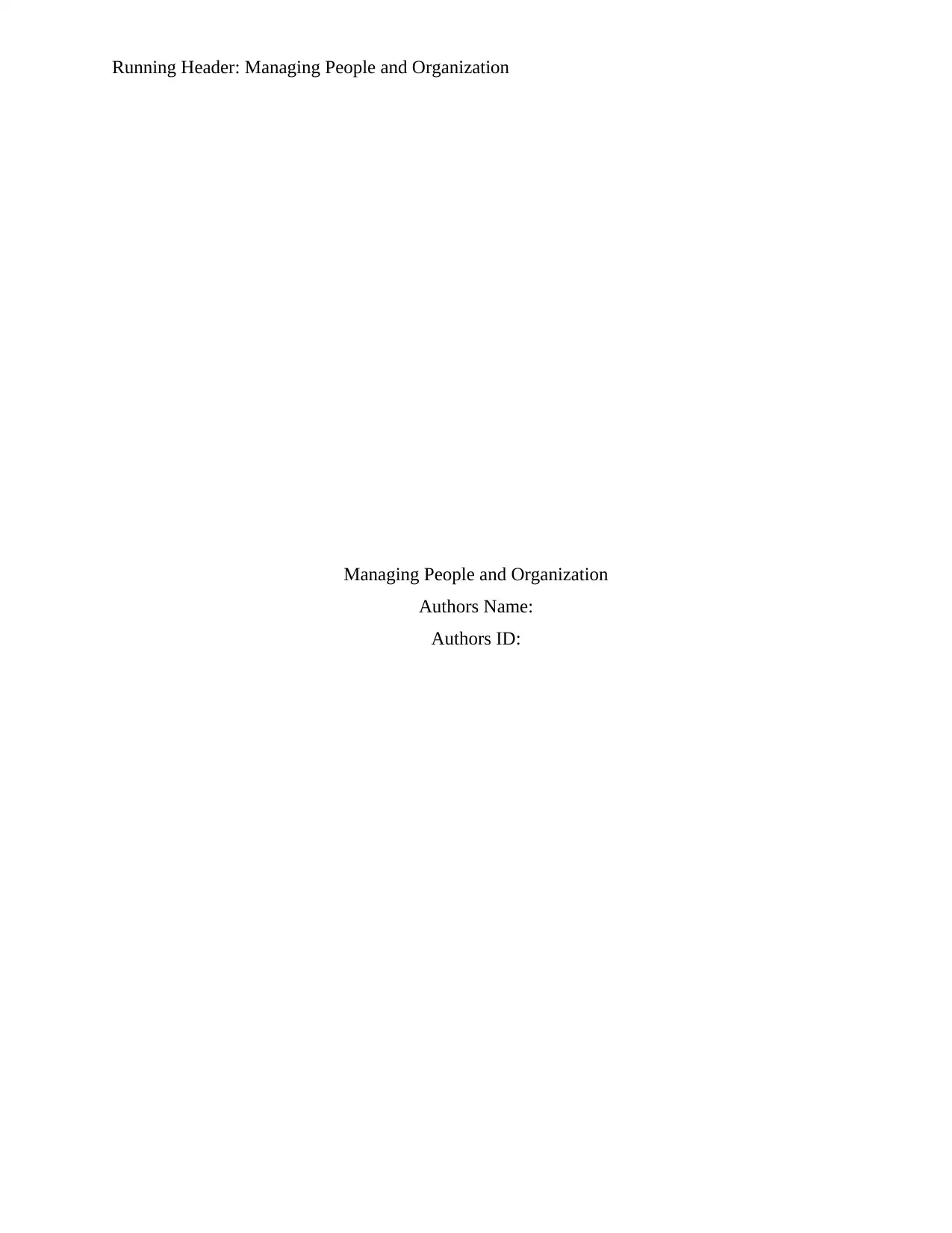
Running Header: Managing People and Organization
Managing People and Organization
Authors Name:
Authors ID:
Managing People and Organization
Authors Name:
Authors ID:
Paraphrase This Document
Need a fresh take? Get an instant paraphrase of this document with our AI Paraphraser
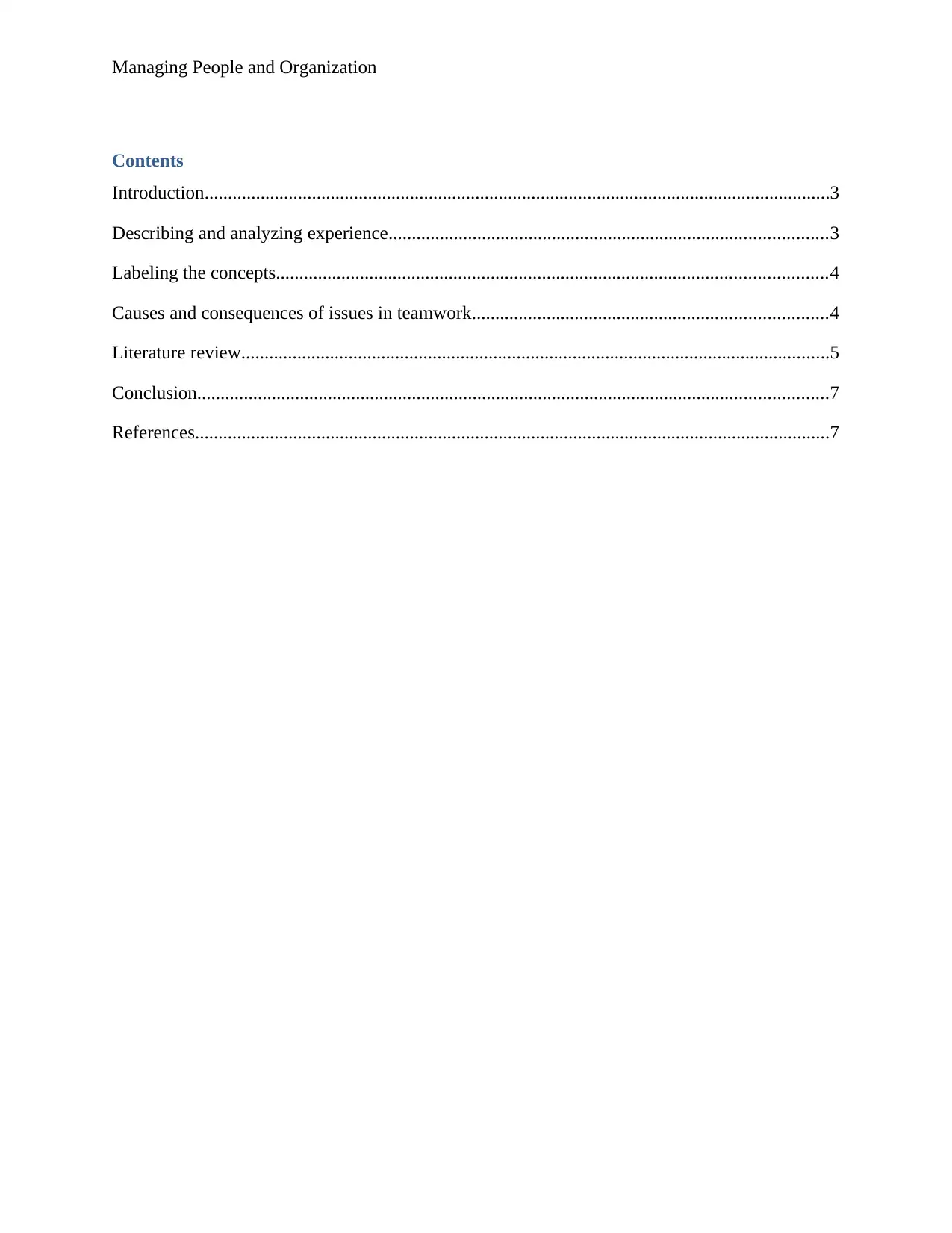
Managing People and Organization
Contents
Introduction......................................................................................................................................3
Describing and analyzing experience..............................................................................................3
Labeling the concepts......................................................................................................................4
Causes and consequences of issues in teamwork............................................................................4
Literature review..............................................................................................................................5
Conclusion.......................................................................................................................................7
References........................................................................................................................................7
Contents
Introduction......................................................................................................................................3
Describing and analyzing experience..............................................................................................3
Labeling the concepts......................................................................................................................4
Causes and consequences of issues in teamwork............................................................................4
Literature review..............................................................................................................................5
Conclusion.......................................................................................................................................7
References........................................................................................................................................7
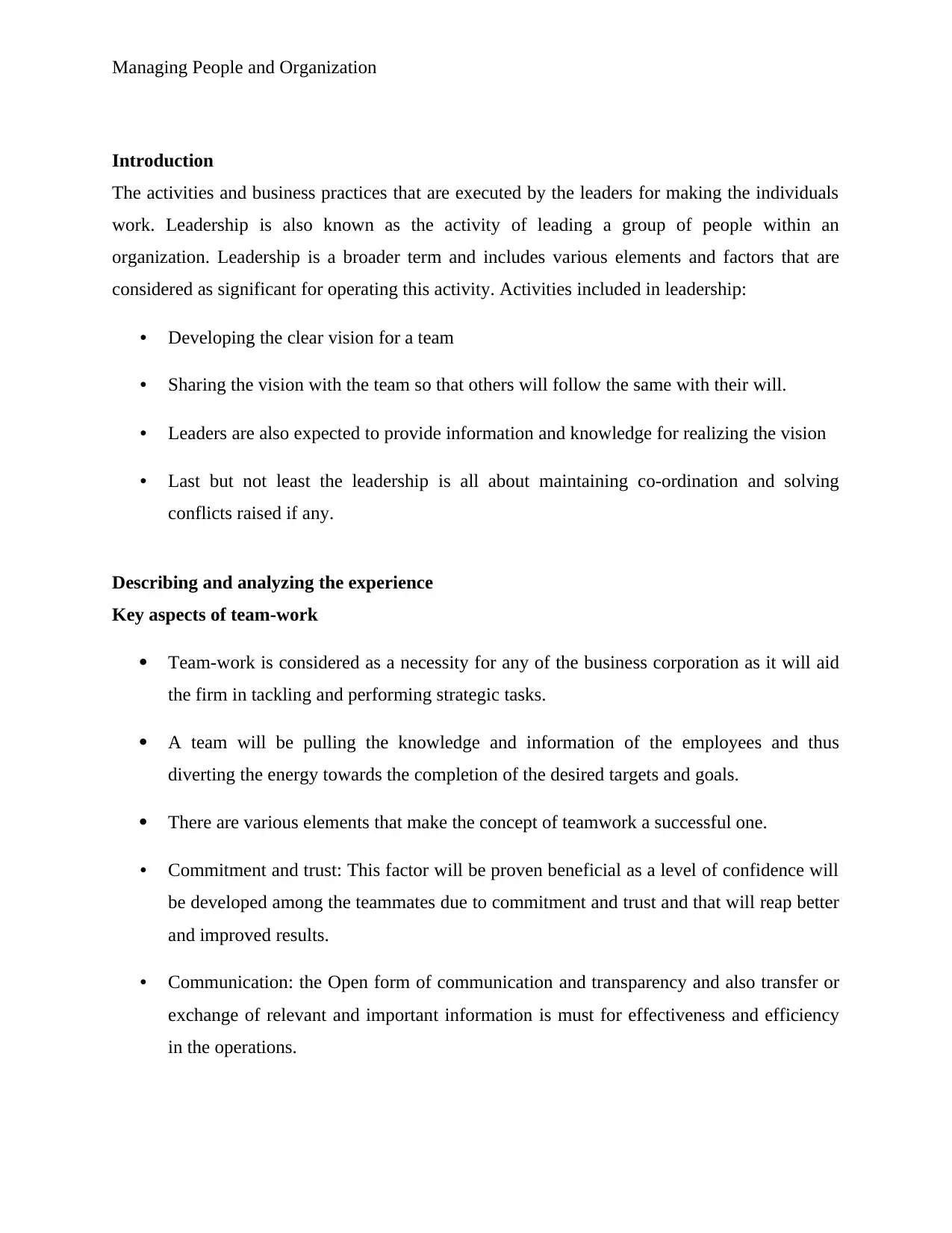
Managing People and Organization
Introduction
The activities and business practices that are executed by the leaders for making the individuals
work. Leadership is also known as the activity of leading a group of people within an
organization. Leadership is a broader term and includes various elements and factors that are
considered as significant for operating this activity. Activities included in leadership:
• Developing the clear vision for a team
• Sharing the vision with the team so that others will follow the same with their will.
• Leaders are also expected to provide information and knowledge for realizing the vision
• Last but not least the leadership is all about maintaining co-ordination and solving
conflicts raised if any.
Describing and analyzing the experience
Key aspects of team-work
Team-work is considered as a necessity for any of the business corporation as it will aid
the firm in tackling and performing strategic tasks.
A team will be pulling the knowledge and information of the employees and thus
diverting the energy towards the completion of the desired targets and goals.
There are various elements that make the concept of teamwork a successful one.
• Commitment and trust: This factor will be proven beneficial as a level of confidence will
be developed among the teammates due to commitment and trust and that will reap better
and improved results.
• Communication: the Open form of communication and transparency and also transfer or
exchange of relevant and important information is must for effectiveness and efficiency
in the operations.
Introduction
The activities and business practices that are executed by the leaders for making the individuals
work. Leadership is also known as the activity of leading a group of people within an
organization. Leadership is a broader term and includes various elements and factors that are
considered as significant for operating this activity. Activities included in leadership:
• Developing the clear vision for a team
• Sharing the vision with the team so that others will follow the same with their will.
• Leaders are also expected to provide information and knowledge for realizing the vision
• Last but not least the leadership is all about maintaining co-ordination and solving
conflicts raised if any.
Describing and analyzing the experience
Key aspects of team-work
Team-work is considered as a necessity for any of the business corporation as it will aid
the firm in tackling and performing strategic tasks.
A team will be pulling the knowledge and information of the employees and thus
diverting the energy towards the completion of the desired targets and goals.
There are various elements that make the concept of teamwork a successful one.
• Commitment and trust: This factor will be proven beneficial as a level of confidence will
be developed among the teammates due to commitment and trust and that will reap better
and improved results.
• Communication: the Open form of communication and transparency and also transfer or
exchange of relevant and important information is must for effectiveness and efficiency
in the operations.
⊘ This is a preview!⊘
Do you want full access?
Subscribe today to unlock all pages.

Trusted by 1+ million students worldwide
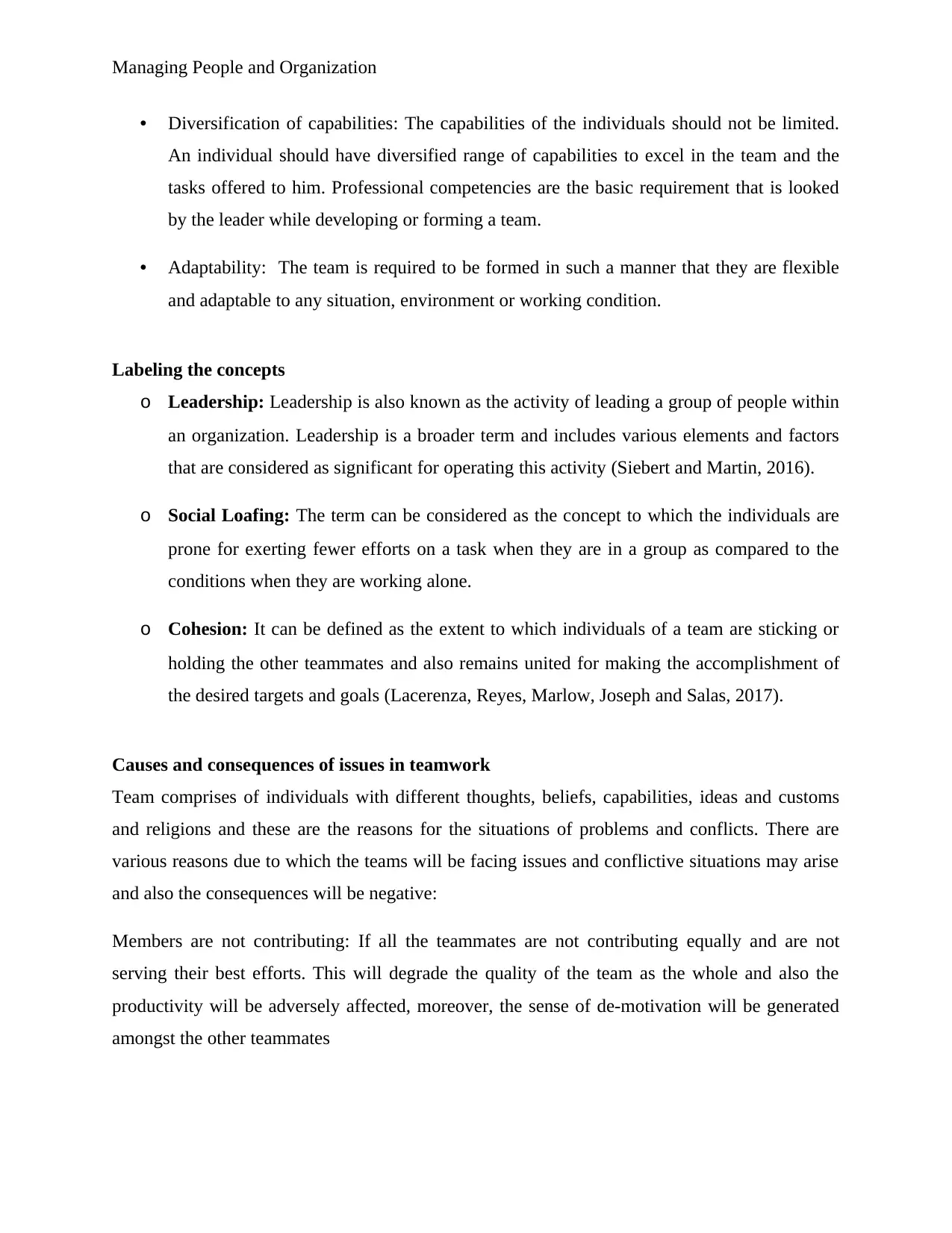
Managing People and Organization
• Diversification of capabilities: The capabilities of the individuals should not be limited.
An individual should have diversified range of capabilities to excel in the team and the
tasks offered to him. Professional competencies are the basic requirement that is looked
by the leader while developing or forming a team.
• Adaptability: The team is required to be formed in such a manner that they are flexible
and adaptable to any situation, environment or working condition.
Labeling the concepts
o Leadership: Leadership is also known as the activity of leading a group of people within
an organization. Leadership is a broader term and includes various elements and factors
that are considered as significant for operating this activity (Siebert and Martin, 2016).
o Social Loafing: The term can be considered as the concept to which the individuals are
prone for exerting fewer efforts on a task when they are in a group as compared to the
conditions when they are working alone.
o Cohesion: It can be defined as the extent to which individuals of a team are sticking or
holding the other teammates and also remains united for making the accomplishment of
the desired targets and goals (Lacerenza, Reyes, Marlow, Joseph and Salas, 2017).
Causes and consequences of issues in teamwork
Team comprises of individuals with different thoughts, beliefs, capabilities, ideas and customs
and religions and these are the reasons for the situations of problems and conflicts. There are
various reasons due to which the teams will be facing issues and conflictive situations may arise
and also the consequences will be negative:
Members are not contributing: If all the teammates are not contributing equally and are not
serving their best efforts. This will degrade the quality of the team as the whole and also the
productivity will be adversely affected, moreover, the sense of de-motivation will be generated
amongst the other teammates
• Diversification of capabilities: The capabilities of the individuals should not be limited.
An individual should have diversified range of capabilities to excel in the team and the
tasks offered to him. Professional competencies are the basic requirement that is looked
by the leader while developing or forming a team.
• Adaptability: The team is required to be formed in such a manner that they are flexible
and adaptable to any situation, environment or working condition.
Labeling the concepts
o Leadership: Leadership is also known as the activity of leading a group of people within
an organization. Leadership is a broader term and includes various elements and factors
that are considered as significant for operating this activity (Siebert and Martin, 2016).
o Social Loafing: The term can be considered as the concept to which the individuals are
prone for exerting fewer efforts on a task when they are in a group as compared to the
conditions when they are working alone.
o Cohesion: It can be defined as the extent to which individuals of a team are sticking or
holding the other teammates and also remains united for making the accomplishment of
the desired targets and goals (Lacerenza, Reyes, Marlow, Joseph and Salas, 2017).
Causes and consequences of issues in teamwork
Team comprises of individuals with different thoughts, beliefs, capabilities, ideas and customs
and religions and these are the reasons for the situations of problems and conflicts. There are
various reasons due to which the teams will be facing issues and conflictive situations may arise
and also the consequences will be negative:
Members are not contributing: If all the teammates are not contributing equally and are not
serving their best efforts. This will degrade the quality of the team as the whole and also the
productivity will be adversely affected, moreover, the sense of de-motivation will be generated
amongst the other teammates
Paraphrase This Document
Need a fresh take? Get an instant paraphrase of this document with our AI Paraphraser
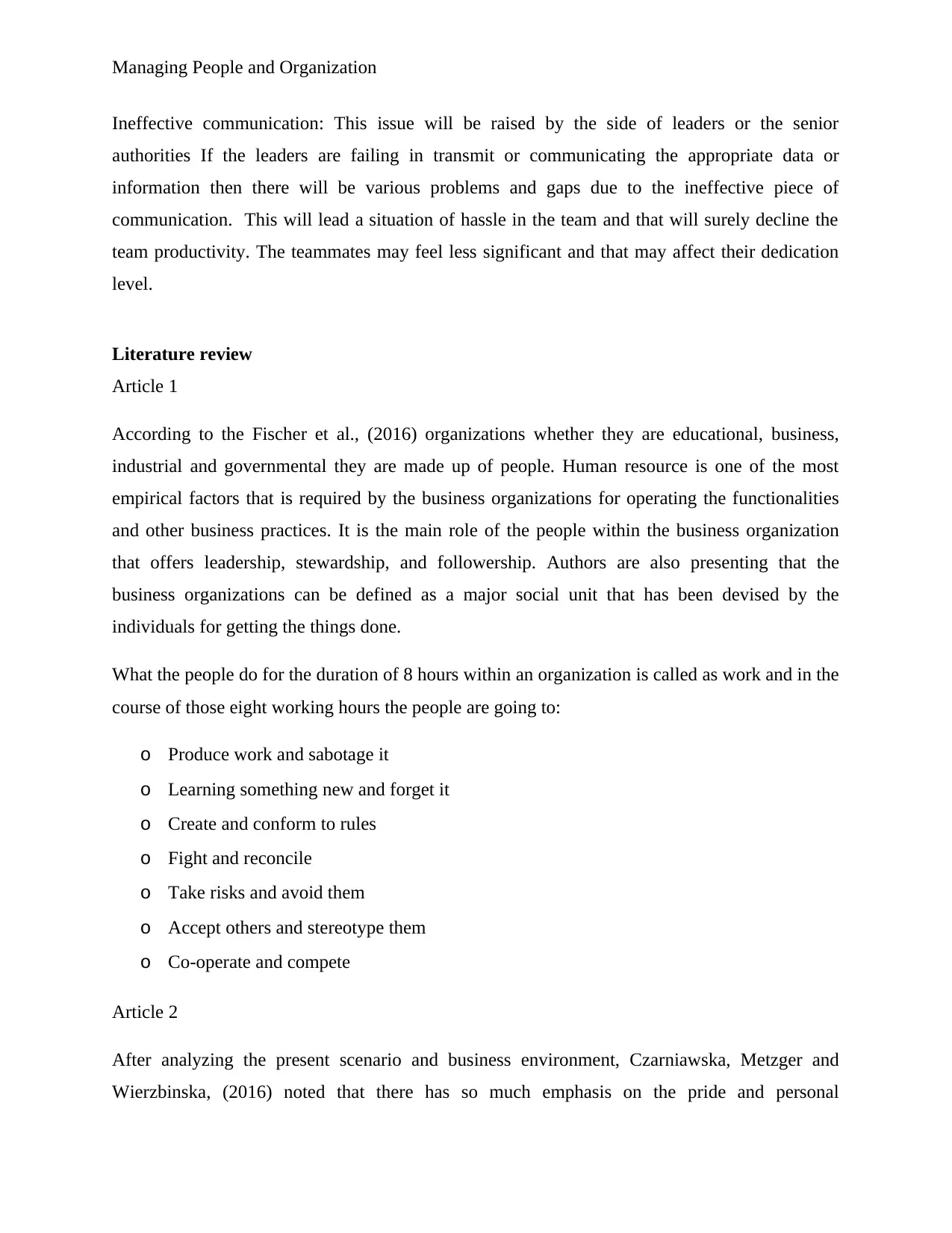
Managing People and Organization
Ineffective communication: This issue will be raised by the side of leaders or the senior
authorities If the leaders are failing in transmit or communicating the appropriate data or
information then there will be various problems and gaps due to the ineffective piece of
communication. This will lead a situation of hassle in the team and that will surely decline the
team productivity. The teammates may feel less significant and that may affect their dedication
level.
Literature review
Article 1
According to the Fischer et al., (2016) organizations whether they are educational, business,
industrial and governmental they are made up of people. Human resource is one of the most
empirical factors that is required by the business organizations for operating the functionalities
and other business practices. It is the main role of the people within the business organization
that offers leadership, stewardship, and followership. Authors are also presenting that the
business organizations can be defined as a major social unit that has been devised by the
individuals for getting the things done.
What the people do for the duration of 8 hours within an organization is called as work and in the
course of those eight working hours the people are going to:
o Produce work and sabotage it
o Learning something new and forget it
o Create and conform to rules
o Fight and reconcile
o Take risks and avoid them
o Accept others and stereotype them
o Co-operate and compete
Article 2
After analyzing the present scenario and business environment, Czarniawska, Metzger and
Wierzbinska, (2016) noted that there has so much emphasis on the pride and personal
Ineffective communication: This issue will be raised by the side of leaders or the senior
authorities If the leaders are failing in transmit or communicating the appropriate data or
information then there will be various problems and gaps due to the ineffective piece of
communication. This will lead a situation of hassle in the team and that will surely decline the
team productivity. The teammates may feel less significant and that may affect their dedication
level.
Literature review
Article 1
According to the Fischer et al., (2016) organizations whether they are educational, business,
industrial and governmental they are made up of people. Human resource is one of the most
empirical factors that is required by the business organizations for operating the functionalities
and other business practices. It is the main role of the people within the business organization
that offers leadership, stewardship, and followership. Authors are also presenting that the
business organizations can be defined as a major social unit that has been devised by the
individuals for getting the things done.
What the people do for the duration of 8 hours within an organization is called as work and in the
course of those eight working hours the people are going to:
o Produce work and sabotage it
o Learning something new and forget it
o Create and conform to rules
o Fight and reconcile
o Take risks and avoid them
o Accept others and stereotype them
o Co-operate and compete
Article 2
After analyzing the present scenario and business environment, Czarniawska, Metzger and
Wierzbinska, (2016) noted that there has so much emphasis on the pride and personal
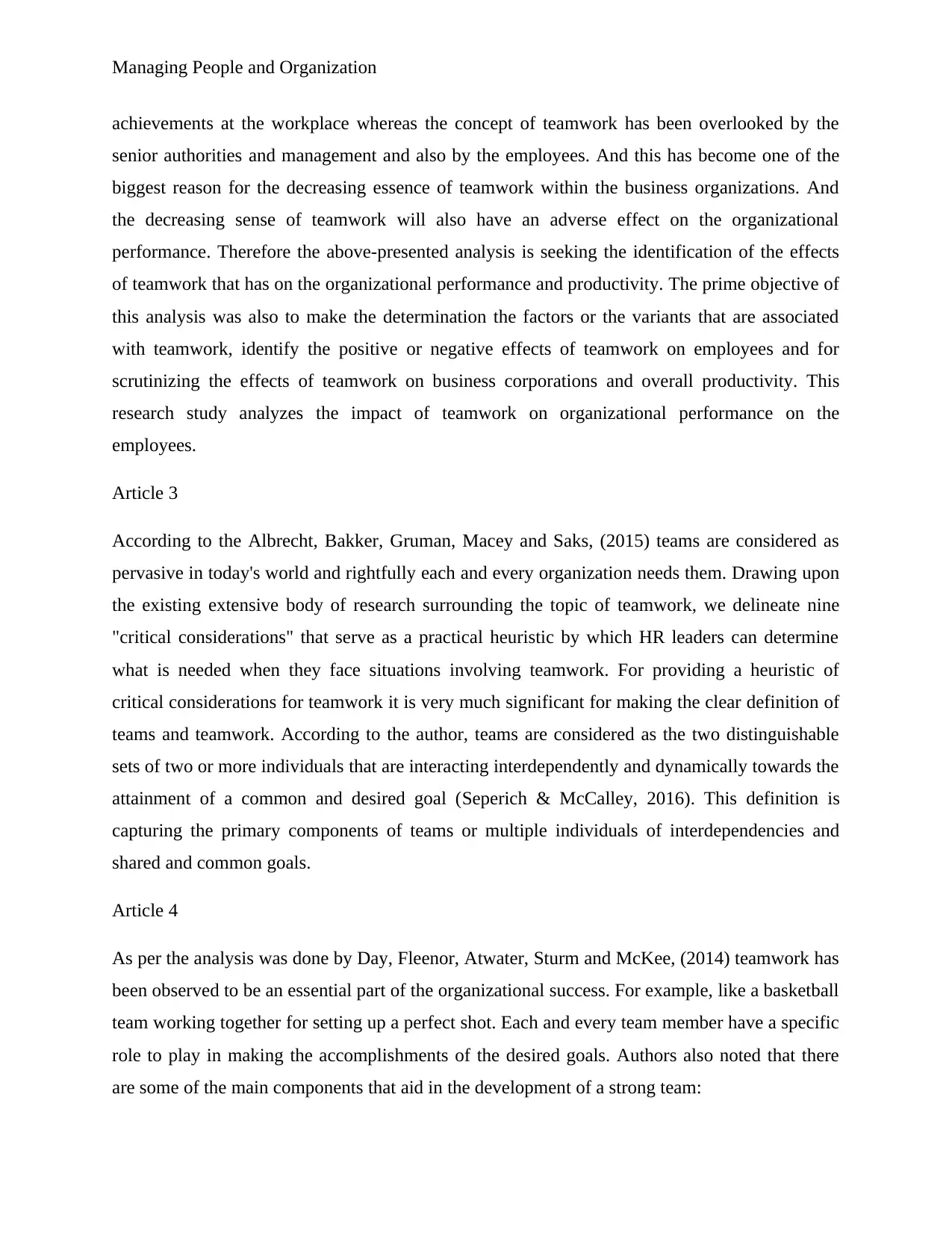
Managing People and Organization
achievements at the workplace whereas the concept of teamwork has been overlooked by the
senior authorities and management and also by the employees. And this has become one of the
biggest reason for the decreasing essence of teamwork within the business organizations. And
the decreasing sense of teamwork will also have an adverse effect on the organizational
performance. Therefore the above-presented analysis is seeking the identification of the effects
of teamwork that has on the organizational performance and productivity. The prime objective of
this analysis was also to make the determination the factors or the variants that are associated
with teamwork, identify the positive or negative effects of teamwork on employees and for
scrutinizing the effects of teamwork on business corporations and overall productivity. This
research study analyzes the impact of teamwork on organizational performance on the
employees.
Article 3
According to the Albrecht, Bakker, Gruman, Macey and Saks, (2015) teams are considered as
pervasive in today's world and rightfully each and every organization needs them. Drawing upon
the existing extensive body of research surrounding the topic of teamwork, we delineate nine
"critical considerations" that serve as a practical heuristic by which HR leaders can determine
what is needed when they face situations involving teamwork. For providing a heuristic of
critical considerations for teamwork it is very much significant for making the clear definition of
teams and teamwork. According to the author, teams are considered as the two distinguishable
sets of two or more individuals that are interacting interdependently and dynamically towards the
attainment of a common and desired goal (Seperich & McCalley, 2016). This definition is
capturing the primary components of teams or multiple individuals of interdependencies and
shared and common goals.
Article 4
As per the analysis was done by Day, Fleenor, Atwater, Sturm and McKee, (2014) teamwork has
been observed to be an essential part of the organizational success. For example, like a basketball
team working together for setting up a perfect shot. Each and every team member have a specific
role to play in making the accomplishments of the desired goals. Authors also noted that there
are some of the main components that aid in the development of a strong team:
achievements at the workplace whereas the concept of teamwork has been overlooked by the
senior authorities and management and also by the employees. And this has become one of the
biggest reason for the decreasing essence of teamwork within the business organizations. And
the decreasing sense of teamwork will also have an adverse effect on the organizational
performance. Therefore the above-presented analysis is seeking the identification of the effects
of teamwork that has on the organizational performance and productivity. The prime objective of
this analysis was also to make the determination the factors or the variants that are associated
with teamwork, identify the positive or negative effects of teamwork on employees and for
scrutinizing the effects of teamwork on business corporations and overall productivity. This
research study analyzes the impact of teamwork on organizational performance on the
employees.
Article 3
According to the Albrecht, Bakker, Gruman, Macey and Saks, (2015) teams are considered as
pervasive in today's world and rightfully each and every organization needs them. Drawing upon
the existing extensive body of research surrounding the topic of teamwork, we delineate nine
"critical considerations" that serve as a practical heuristic by which HR leaders can determine
what is needed when they face situations involving teamwork. For providing a heuristic of
critical considerations for teamwork it is very much significant for making the clear definition of
teams and teamwork. According to the author, teams are considered as the two distinguishable
sets of two or more individuals that are interacting interdependently and dynamically towards the
attainment of a common and desired goal (Seperich & McCalley, 2016). This definition is
capturing the primary components of teams or multiple individuals of interdependencies and
shared and common goals.
Article 4
As per the analysis was done by Day, Fleenor, Atwater, Sturm and McKee, (2014) teamwork has
been observed to be an essential part of the organizational success. For example, like a basketball
team working together for setting up a perfect shot. Each and every team member have a specific
role to play in making the accomplishments of the desired goals. Authors also noted that there
are some of the main components that aid in the development of a strong team:
⊘ This is a preview!⊘
Do you want full access?
Subscribe today to unlock all pages.

Trusted by 1+ million students worldwide
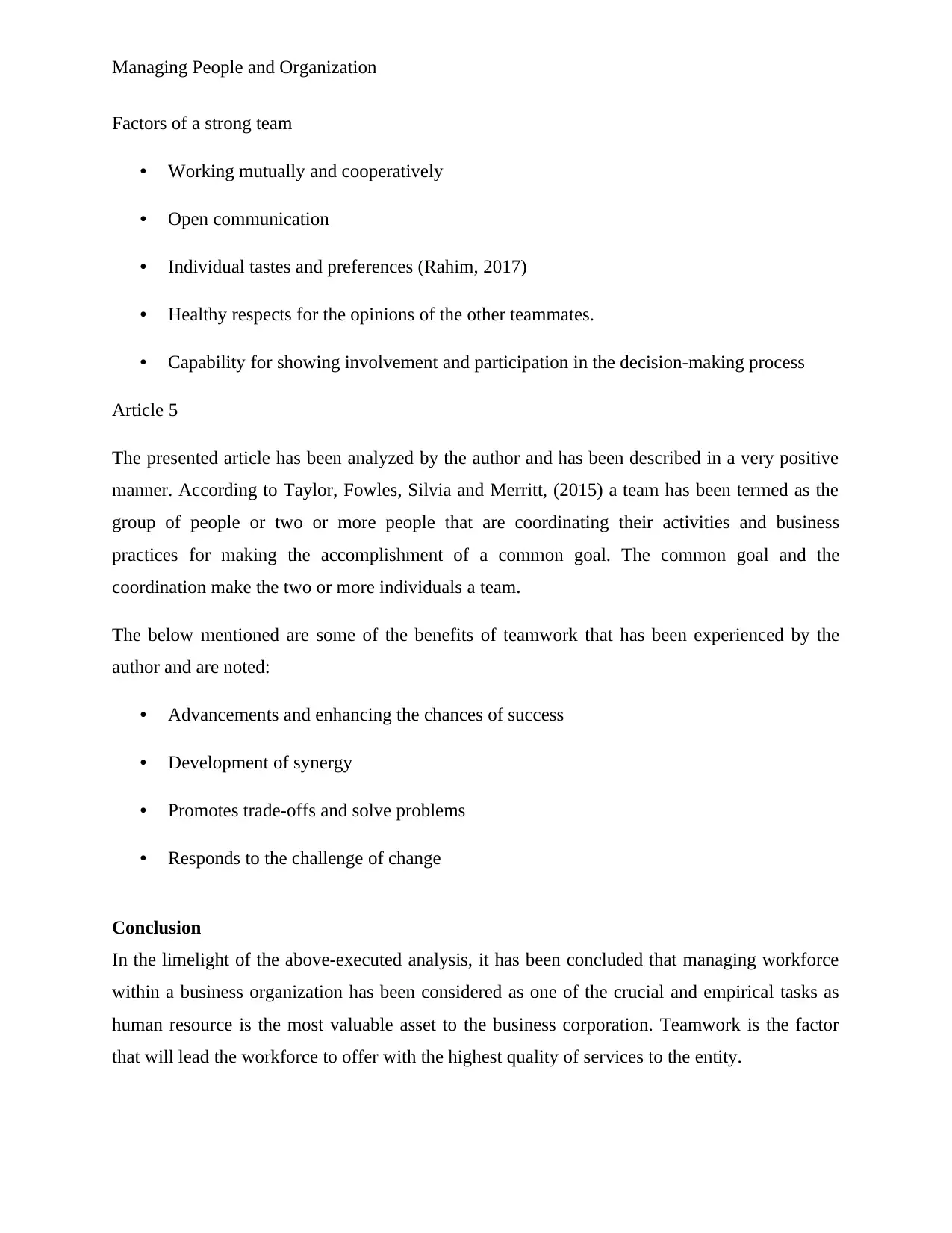
Managing People and Organization
Factors of a strong team
• Working mutually and cooperatively
• Open communication
• Individual tastes and preferences (Rahim, 2017)
• Healthy respects for the opinions of the other teammates.
• Capability for showing involvement and participation in the decision-making process
Article 5
The presented article has been analyzed by the author and has been described in a very positive
manner. According to Taylor, Fowles, Silvia and Merritt, (2015) a team has been termed as the
group of people or two or more people that are coordinating their activities and business
practices for making the accomplishment of a common goal. The common goal and the
coordination make the two or more individuals a team.
The below mentioned are some of the benefits of teamwork that has been experienced by the
author and are noted:
• Advancements and enhancing the chances of success
• Development of synergy
• Promotes trade-offs and solve problems
• Responds to the challenge of change
Conclusion
In the limelight of the above-executed analysis, it has been concluded that managing workforce
within a business organization has been considered as one of the crucial and empirical tasks as
human resource is the most valuable asset to the business corporation. Teamwork is the factor
that will lead the workforce to offer with the highest quality of services to the entity.
Factors of a strong team
• Working mutually and cooperatively
• Open communication
• Individual tastes and preferences (Rahim, 2017)
• Healthy respects for the opinions of the other teammates.
• Capability for showing involvement and participation in the decision-making process
Article 5
The presented article has been analyzed by the author and has been described in a very positive
manner. According to Taylor, Fowles, Silvia and Merritt, (2015) a team has been termed as the
group of people or two or more people that are coordinating their activities and business
practices for making the accomplishment of a common goal. The common goal and the
coordination make the two or more individuals a team.
The below mentioned are some of the benefits of teamwork that has been experienced by the
author and are noted:
• Advancements and enhancing the chances of success
• Development of synergy
• Promotes trade-offs and solve problems
• Responds to the challenge of change
Conclusion
In the limelight of the above-executed analysis, it has been concluded that managing workforce
within a business organization has been considered as one of the crucial and empirical tasks as
human resource is the most valuable asset to the business corporation. Teamwork is the factor
that will lead the workforce to offer with the highest quality of services to the entity.
Paraphrase This Document
Need a fresh take? Get an instant paraphrase of this document with our AI Paraphraser

Managing People and Organization
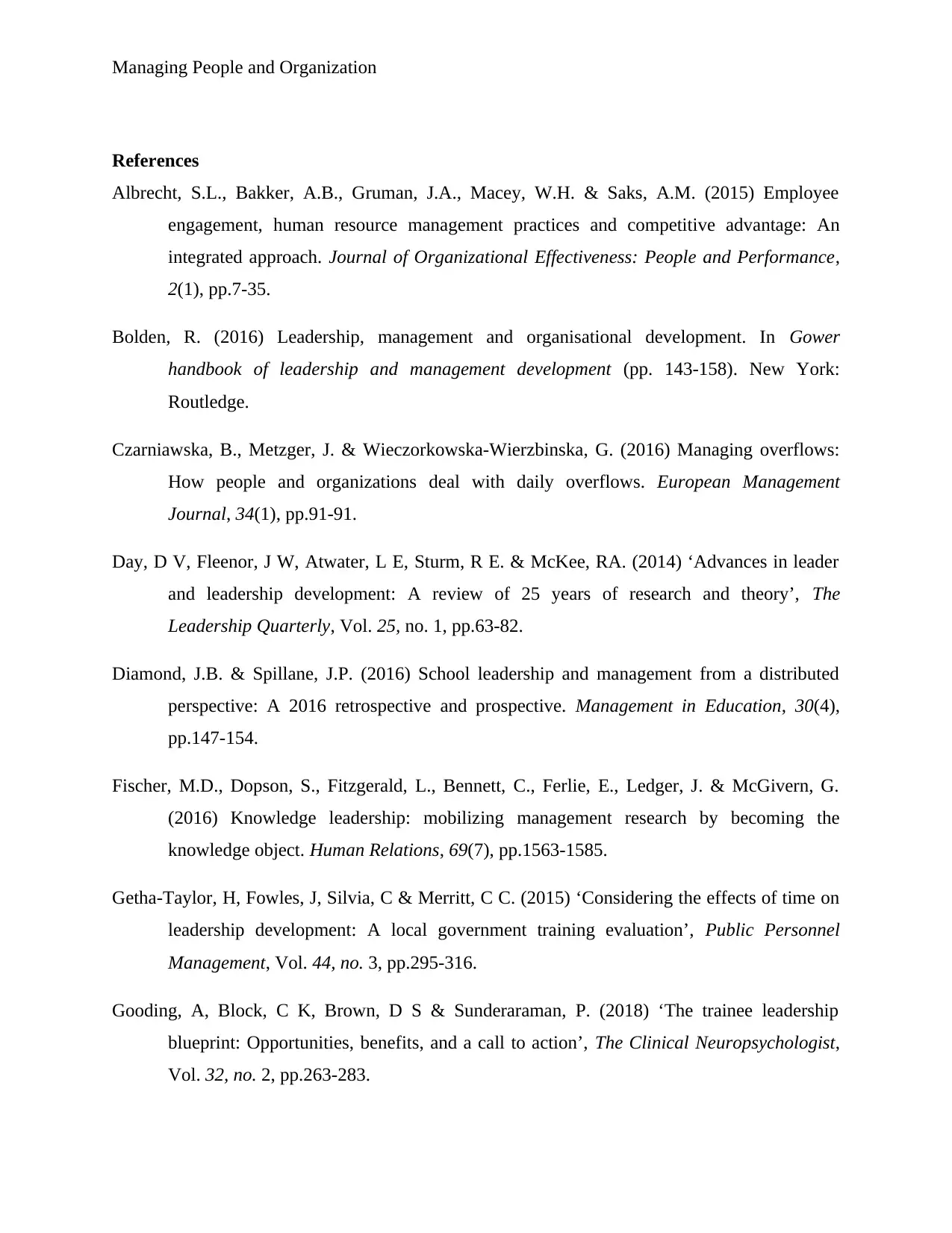
Managing People and Organization
References
Albrecht, S.L., Bakker, A.B., Gruman, J.A., Macey, W.H. & Saks, A.M. (2015) Employee
engagement, human resource management practices and competitive advantage: An
integrated approach. Journal of Organizational Effectiveness: People and Performance,
2(1), pp.7-35.
Bolden, R. (2016) Leadership, management and organisational development. In Gower
handbook of leadership and management development (pp. 143-158). New York:
Routledge.
Czarniawska, B., Metzger, J. & Wieczorkowska-Wierzbinska, G. (2016) Managing overflows:
How people and organizations deal with daily overflows. European Management
Journal, 34(1), pp.91-91.
Day, D V, Fleenor, J W, Atwater, L E, Sturm, R E. & McKee, RA. (2014) ‘Advances in leader
and leadership development: A review of 25 years of research and theory’, The
Leadership Quarterly, Vol. 25, no. 1, pp.63-82.
Diamond, J.B. & Spillane, J.P. (2016) School leadership and management from a distributed
perspective: A 2016 retrospective and prospective. Management in Education, 30(4),
pp.147-154.
Fischer, M.D., Dopson, S., Fitzgerald, L., Bennett, C., Ferlie, E., Ledger, J. & McGivern, G.
(2016) Knowledge leadership: mobilizing management research by becoming the
knowledge object. Human Relations, 69(7), pp.1563-1585.
Getha-Taylor, H, Fowles, J, Silvia, C & Merritt, C C. (2015) ‘Considering the effects of time on
leadership development: A local government training evaluation’, Public Personnel
Management, Vol. 44, no. 3, pp.295-316.
Gooding, A, Block, C K, Brown, D S & Sunderaraman, P. (2018) ‘The trainee leadership
blueprint: Opportunities, benefits, and a call to action’, The Clinical Neuropsychologist,
Vol. 32, no. 2, pp.263-283.
References
Albrecht, S.L., Bakker, A.B., Gruman, J.A., Macey, W.H. & Saks, A.M. (2015) Employee
engagement, human resource management practices and competitive advantage: An
integrated approach. Journal of Organizational Effectiveness: People and Performance,
2(1), pp.7-35.
Bolden, R. (2016) Leadership, management and organisational development. In Gower
handbook of leadership and management development (pp. 143-158). New York:
Routledge.
Czarniawska, B., Metzger, J. & Wieczorkowska-Wierzbinska, G. (2016) Managing overflows:
How people and organizations deal with daily overflows. European Management
Journal, 34(1), pp.91-91.
Day, D V, Fleenor, J W, Atwater, L E, Sturm, R E. & McKee, RA. (2014) ‘Advances in leader
and leadership development: A review of 25 years of research and theory’, The
Leadership Quarterly, Vol. 25, no. 1, pp.63-82.
Diamond, J.B. & Spillane, J.P. (2016) School leadership and management from a distributed
perspective: A 2016 retrospective and prospective. Management in Education, 30(4),
pp.147-154.
Fischer, M.D., Dopson, S., Fitzgerald, L., Bennett, C., Ferlie, E., Ledger, J. & McGivern, G.
(2016) Knowledge leadership: mobilizing management research by becoming the
knowledge object. Human Relations, 69(7), pp.1563-1585.
Getha-Taylor, H, Fowles, J, Silvia, C & Merritt, C C. (2015) ‘Considering the effects of time on
leadership development: A local government training evaluation’, Public Personnel
Management, Vol. 44, no. 3, pp.295-316.
Gooding, A, Block, C K, Brown, D S & Sunderaraman, P. (2018) ‘The trainee leadership
blueprint: Opportunities, benefits, and a call to action’, The Clinical Neuropsychologist,
Vol. 32, no. 2, pp.263-283.
⊘ This is a preview!⊘
Do you want full access?
Subscribe today to unlock all pages.

Trusted by 1+ million students worldwide
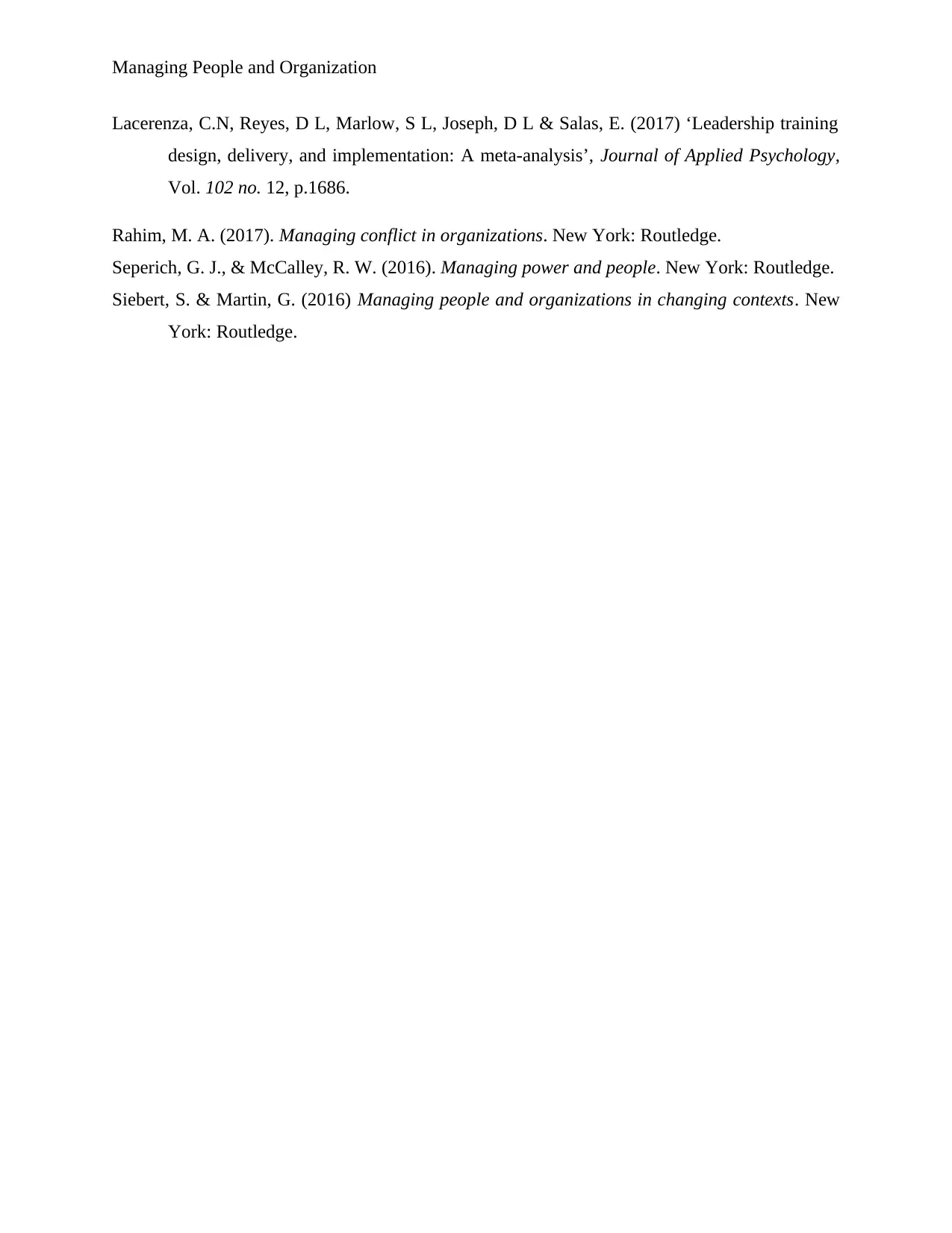
Managing People and Organization
Lacerenza, C.N, Reyes, D L, Marlow, S L, Joseph, D L & Salas, E. (2017) ‘Leadership training
design, delivery, and implementation: A meta-analysis’, Journal of Applied Psychology,
Vol. 102 no. 12, p.1686.
Rahim, M. A. (2017). Managing conflict in organizations. New York: Routledge.
Seperich, G. J., & McCalley, R. W. (2016). Managing power and people. New York: Routledge.
Siebert, S. & Martin, G. (2016) Managing people and organizations in changing contexts. New
York: Routledge.
Lacerenza, C.N, Reyes, D L, Marlow, S L, Joseph, D L & Salas, E. (2017) ‘Leadership training
design, delivery, and implementation: A meta-analysis’, Journal of Applied Psychology,
Vol. 102 no. 12, p.1686.
Rahim, M. A. (2017). Managing conflict in organizations. New York: Routledge.
Seperich, G. J., & McCalley, R. W. (2016). Managing power and people. New York: Routledge.
Siebert, S. & Martin, G. (2016) Managing people and organizations in changing contexts. New
York: Routledge.
1 out of 10
Related Documents
Your All-in-One AI-Powered Toolkit for Academic Success.
+13062052269
info@desklib.com
Available 24*7 on WhatsApp / Email
![[object Object]](/_next/static/media/star-bottom.7253800d.svg)
Unlock your academic potential
Copyright © 2020–2025 A2Z Services. All Rights Reserved. Developed and managed by ZUCOL.




